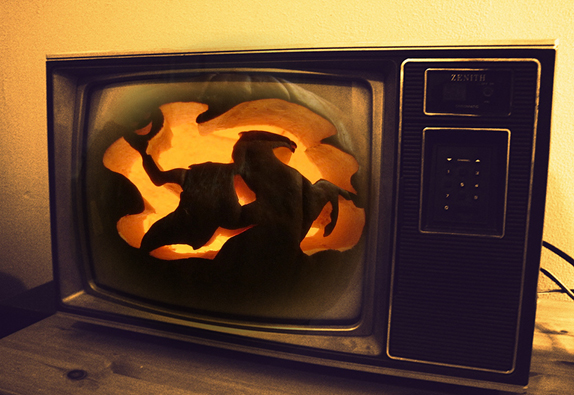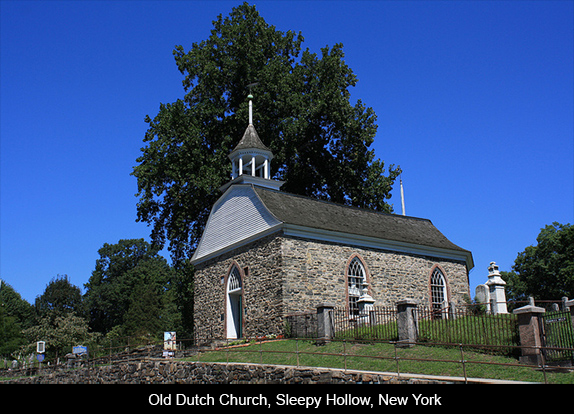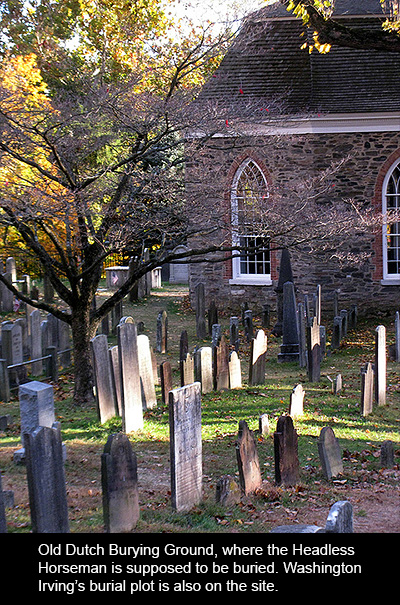
I was born at Sleepy Hollow, in New York, a village that Washington Irving described as, “one of those spacious coves which indent the eastern shore of the Hudson, at that broad expansion of the river denominated by the ancient Dutch navigators the Tappan Zee…there lies a small market town or rural port…which is more generally and properly known by the name of Tarry Town. Not far from this village, perhaps about two miles, there is a little valley or rather lap of land among high hills, which is one of the quietest places in the whole world. A small brook glides through it, with just murmur enough to lull one to repose.”
That brook ran under the infamous Headless Horseman Bridge, long gone by my time, replaced by a modern concrete structure that delivers traffic north and south along old Route 9, the Albany Post Road. The wrought iron gates of Sleepy Hollow Cemetery stand at this juncture, and just inside the entrance is found the Old Dutch Church, the oldest church structure in New York, dating to 1685.

The Dutch Republic had colonized New Amsterdam before being driven out of the New World by the British. And in the building’s rear lie the graves of those early settlers. Farther up a gentle slope lies the Irving plot, Washington’s headstone in the center, twice as tall as his family members.
Irving, who didn’t believe in ghosts, wrote his short story utilizing the folk tales and myths around the story of the Headless Horseman, a Hessian soldier fighting for the British who lost his head in battle and, according to legend, roamed the plots of the cemetery at night in search of his missing cranium. As a boy my pals and I used to roam those historic plots, especially on All Hallows’ Eve, in search of this spooky horseman, seeing goblins behind every tombstone, scaring ourselves to death but never glimpsing his apparition. Did we believe in ghosts? No, but the thrill of it made October 31st a special night of our young years.

Now there is a new show on NBC called Sleepy Hollow that has brought Irving’s Headless Horseman to life, so to speak, as only TV could do—ignoring the original story, demolishing credibility, making Ichabod Crane a former British army officer, who was killed in battle and brought back from the dead to present day Sleepy Hollow. Irving’s Crane was a schoolteacher, “tall and lank” with a small head, “To see him striding along the profile of a hill on a windy day, with his clothes bagging and fluttering about him, one might have mistaken him for the genius of famine descending upon the earth, or some scarecrow eloped from a cornfield.”
Ichabod was sweet on the local beauty, Katrina Van Tassel, but her beau was Bones Brom, who devised a ploy to rid the village of Crane by riding his horse in pursuit of Crane one dark night holding aloft a lighted pumpkin to simulate the Horseman’s head, in order to scare off the gullible bumpkin. Needless to say, it worked, and the schoolmaster was not seen again. “The old country wives, however, who are the best judges of these matters, maintain to this day that Ichabod was spirited away by supernatural means; and it is a favorite story often told about the neighborhood round the winter evening fire.”
Undoubtedly, Irving, who was a newspaper man, heard these stories and wove them into a gentle satire of life in the hinterlands of Westchester County.
Instead, the producers have given us this equestrian demon, revealed as the Fourth Horsemen of the Apocalypse—Death—a fully supernatural entity, and the now hunky Ichabod (Tom Mison), recently resurrected, who has come to aid a female police lieutenant (Nicole Beharie) in solving some mysterious beheadings and to eventually try to destroy the demon rider—which is a kind way to describe the unfathomable plot lines.
The influence of the Hollywood mind-set, permeating virtually ever corner of TV drama, has once again rewritten our history, something they are wont to do. As long as viewers respond to supernatural stories, TV and films will continue to churn this stuff out. “Sleepy Hollow” returns in the fall.
Fifty-three years ago FCC chairman Newton Minow made a speech to the National Association of Broadcasters (NAB) in which he called television a “vast wasteland” accusing the industry of an endless procession of game shows, formula comedies, mayhem, violence, sadism, murder, private eyes, and more violence. And endless commercials. Although Minow’s speech was rated one of twenty-five “Speeches That Changed the World,” today it doesn’t seem that the electronic landscape has changed that much. More networks, more profits, same drivel.
I was in broadcasting school when Minow gave his famous speech; we discussed it and there was a general feeling that we were the ones who were going to change television. His words made us dream of a new future.
Mr. Minow also said, “When television is good, nothing…nothing is better,” he told those broadcasters in 1961, and added “I urge you to put the people's airwaves to the service of the people and the cause of freedom. You must help prepare a generation for great decisions. You must help a great nation fulfill its future.”
Television, the greatest tool for change we possess, has not yet fulfilled that future.
In his speech Minow also shared advice to his audience:
"Television and all who participate in it are jointly accountable to the American public for respect for the special needs of children, for community responsibility, for the advancement of education and culture, for the acceptability of the program materials chosen, for decency and decorum in production, and for propriety in advertising. This responsibility cannot be discharged by any given group of programs, but can be discharged only through the highest standards of respect for the American home, applied to every moment of every program presented by television.Program materials should enlarge the horizons of the viewer, provide him with wholesome entertainment, afford helpful stimulation, and remind him of the responsibilities which the citizen has toward his society."[2]
This speech is properly titled "Television and the Public Interest". It was a landmark speech for the medium of television, at a time when there were only three networks in the United States and when the realm of television was much less vast than it would later become. Nonetheless, it is counted as one of a hundred best American speeches of the 20th century by several authorities and selected as one of twenty-five 'Speeches that Changed the World' by Vital Speeches.[3] Related writings include his book (co-written with Craig LaMay) Abandoned in the Wasteland: Children, Television, & the First Amendment.
(Photos: Pumpkin by Ted &Dani Percival, TV by Sarah Reid, Old Dutch Church by csouza_79)

July 11, 2014